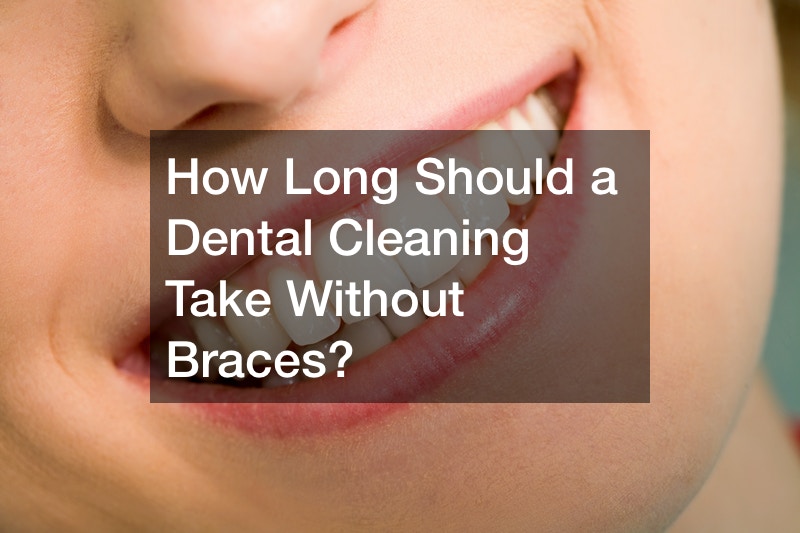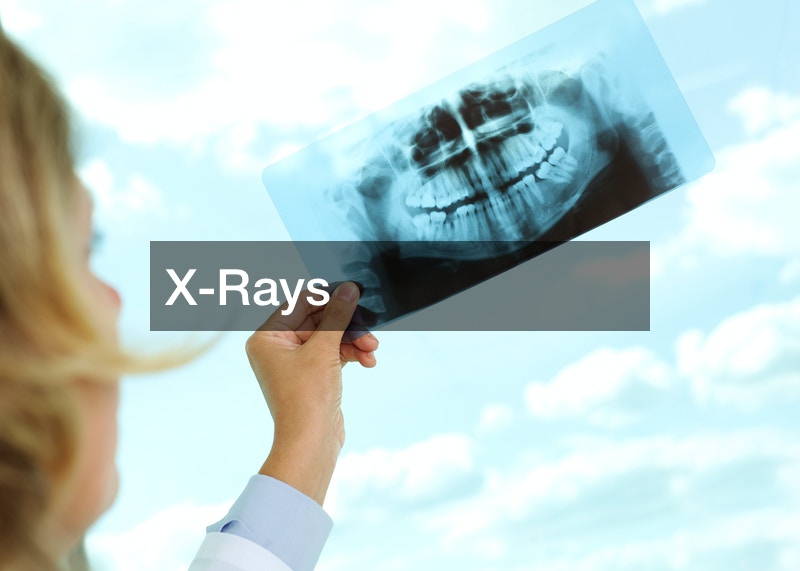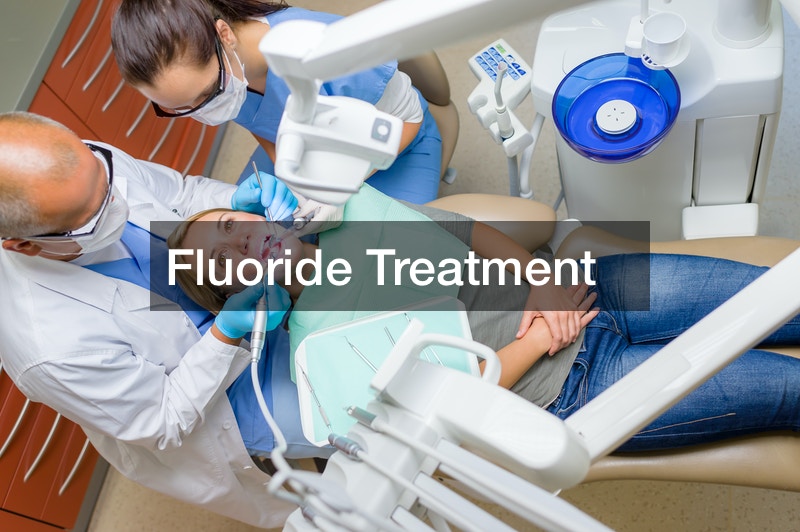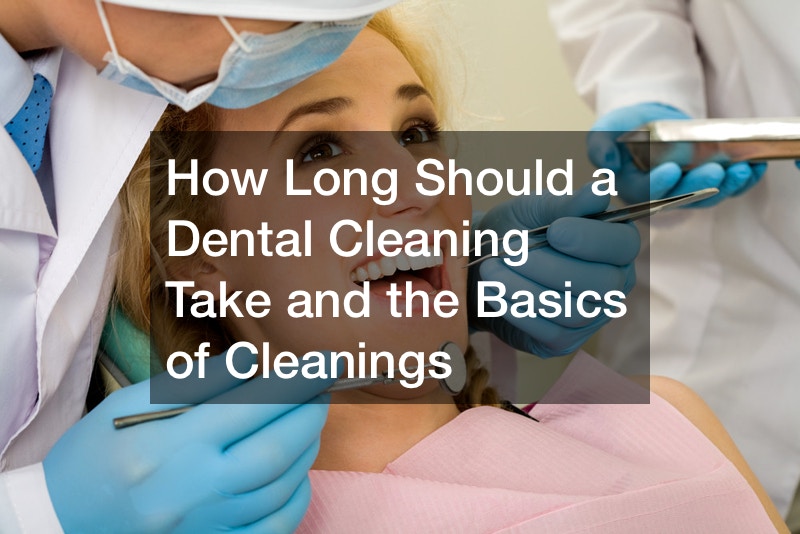
Dental cleaning plays a vital role in both dental and overall wellbeing. Most family dentists recommend going for a dental cleaning at least twice a year. Why? Because there is a link between oral hygiene and overall wellbeing. During general health check-ups, physicians check all body organs, including the heart, kidneys, lungs, muscles, skin, etc.
If a physician notices problems during the check-up, they can recommend specialized exams or give you medication. A dental exam, on the other hand, covers all parts of your mouth and throat, including bones, gums, soft tissues, and teeth. If your local dentist finds problems, they can send you to a specialized dental clinic for dental cleaning.
How Long Should a Dental Cleaning Take Without Braces?

Dental cleaning is a basic general dentistry procedure used to assess oral health. Dental cleaning without braces should take roughly between 30 minutes and 60 minutes. It might seem long, but there is no need to rush throughout the entire procedure. Your dentist should move at a pace that makes you feel calm and collected. It’s vital that you inform your dentist if you experience any pain, and they can take breaks. But for most people, this is a routine process that’s relatively painless, and they should be calm from beginning to end.
How Long Should a Dental Cleaning Take With Braces?
Similar to anything related to braces, dental cleaning with braces can take longer. Why? Because the wiring and brackets make it hard for the dentist to move their tools inside your mouth. But it’s equally important to get a dental cleaning even if you have braces. On average, the entire process should take between an hour and an hour and a half.
What Can Affect How Long a Dental Cleaning Lasts?
How long should a dental cleaning take can be affected by several factors, including:
Anxiety Levels

If you have anxiety, it can take more time for a dental practitioner to clean your teeth. Fortunately, most dental hygienists understand that this process is intensive for some, meaning if they notice you’re anxious, they will clean your teeth at a slower pace than usual.
This will help you become comfortable, and they can distract you by explaining what steps they will take to clean your teeth and how they will do it. For some dentists calming patients is standard practice, so they will do it regardless of whether you have anxiety or not. For severe cases of pressure, the dental hygienist can administer a sedative.
Gum Disease
When the spaces between your teeth and the surrounding gum tissues are infected, the gum tissue withdraws from your teeth. Such areas need to be thoroughly cleaned to eliminate the risk of periodontal disease. The process involved is more intensive the usual. Hence, it takes more time. You might need to see a periodontist if your gum problem is severe.
Teeth Condition
Dental practitioners clean your teeth to remove plaque, stains, and tartar. The amount of plaque accumulation is directly connected to how well and often you observe oral hygiene. The more you brush and floss your teeth, the less plaque and tartar build-up. Stains, on the other hand, appear due to typical drinking and eating, but smoking cigarettes or drinking tea or coffee often, can cause your teeth to have more stains.
How to Reduce the Duration of a Dental Cleaning?
If you’re wondering how long should a dental cleaning take, know that you have a part to play in this. How? While dental hygienists work thoroughly as quickly as possible, there are a couple of things you can do to reduce the duration of your dental cleaning:
- Request for paperwork ahead of time and fill it out.
- Have a list of any prescription, OTC (over-the-counter) medicine, and supplements you take. Also, have a list of existing health conditions.
- Practice oral hygiene often and adequately by brushing and flossing.
- Make sure you undergo dental cleaning at least twice a year.
The Basics of Dental Cleaning
Professional dental cleaning comprises a couple of essential steps. They include:
Checking Your Teeth and Gums
Dental cleaning starts with a thorough evaluation of your teeth. To do this, your dental practitioner uses a small mirror to inspect your teeth for issues such as plaque and tartar accumulation, swollen gums, and stained teeth. The evaluation helps the dental hygienist pinpoint issues and address them during cleaning. The dental hygienist will inform your family dentistry practitioner about any cavities or gum problems they find. The amount of time this step takes depends on the health of your teeth and gums.
X-Rays

X-rays are done during dental cleaning to check the areas around and between your teeth to see if cavities are present. X-rays also show the state of the bones that support your teeth. Dental cleaning only involves digital x-rays to reduce radiation exposure. If cavities are present, the dental hygienist can recommend you visit a dentist to discuss the issue and recommend further treatment such as damaged tooth repair.
Plaque and Tartar Removal
Brushing your teeth often removes a lot of plaque but some remains even with proper oral hygiene. Plaque is a tacky, clear layer created by food and drink remains as well as saliva. It facilitates the growth of bacteria which destroys your teeth and causes cavities. In such an instance, you might need wisdom teeth removal and replacement. Also, if it settles below the gum line, you can get periodontal (gum) disease.
Ultimately plaque hardens and becomes tartar. Tartar should only be removed by a dental practitioner such as a dental hygienist during teeth cleaning. Dental practitioners use special tools (scalers) to carefully remove plaque and tartar along the gum line and from your teeth. This is known as scaling, and scalers are used to clean each tooth to eliminate stains and build-up. The dentist then rinses the cleaned areas to remove any blood or deposits. If plaque has accumulated under the gum line, you need to undergo deep cleaning.
Polishing
After this step, the next step of the dental cleaning process is polishing. Your dental hygienist will apply mildly abrasive paste known as prophylaxis paste on your teeth and proceed to polish them using a handheld electric tool. This evens the surface of your teeth, helps your gums stick to your teeth, and prevents plaque build-up.
Flossing
The next step your hygienist does to clean your teeth is flossing them. This step is crucial because it helps eliminate any residual plaque and tartar between your teeth. Although dentists recommend cleaning after about six months, they can suggest you have your teeth cleaned more times, depending on your oral hygiene. Otherwise, you might find that you need dental implants because your oral hygiene is subpar. When you get your teeth cleaned regularly, you won’t be wondering how long should a dental cleaning take because each cleaning appointment will take less time and won’t cause you pain or discomfort.
Rinsing
In this step, your dental hygienist will spray some water inside your mouth. Once you’re done, you don’t spit the water; instead, your hygienist will remove the water using a suction tool. Rinsing helps remove any remaining tooth polish.
Fluoride Treatment

Sometimes your dental hygienist can recommend fluoride treatment at the end of your dental cleaning process. Why? To improve your dental health if they notice it’s subpar. Fluoride is a naturally occurring substance that helps strengthen teeth, and while many water treatment plants add fluoride to drinking water, you might still need fluoride treatment. Fluoride treatment comprises wearing a mouthpiece filled with fluoride paste for about a minute so you won’t be left wondering how long should a dental cleaning take. Fluoride pastes are available in numerous flavors, therefore, you can pick the flavor you are comfortable with.
Final Examination With a Dentist
Once you’re done with your dental hygienist, a dentist will come and do a follow-up. If they don’t find any oral hygiene problems, you’re okay. Your dentist is best placed to answer any questions you might have regarding the cleaning process.
Your dentist can ask whether you want to schedule another professional dental cleaning job. Note professional dental cleaning, like cosmetic dentistry, has side effects. For instance, your gums can bleed if you have lingering dental problems such as periodontal disease.
What About Deep Cleaning?
Something else to make you wonder how long should a dental cleaning take is deep cleaning. This type of professional dental cleaning takes longer than the typical one depending on the level of cleaning needed. Deep cleaning doesn’t have to be done on all teeth; your mouth can be split into quadrants. If only one quadrant needs to be cleaned, it won’t take a lot of time, but if all quadrants need to be cleaned, you’ll be left wondering how long should a dental cleaning take because one appointment can last up to two hours. Also, you might need to follow up appointments with your hygienist to confirm the cleaning was effective.
Does Deep Cleaning Hurt?
Deep cleaning is a bit uncomfortable, so your hygienist might use an anesthetic. For some people, only a topical anesthetic is needed; for others, the dentist might go for something more robust like Novocain to ensure no pain is felt during the process. Once the anesthetic has settled in your body, your dental hygienist can begin to work.
Keep in mind that the time it takes for the anesthetic to take effect depends on the person and the amount administered. If you’re anxious or concerned about the pain you might experience during deep cleaning, there are several options we’ve listed above. Talk to your dentist about how you feel, don’t allow the fear of pain to deny you the dental care you need. To finish up deep teeth cleaning, your dentist can finish by injecting an antibiotic into the gum pockets to remove any residual bacteria while your teeth seal themselves against the roots.
Why Should You Get a Professional Dental Cleaning?
Dental Cleaning Helps to Brighten Your Smile
Professional dental cleaning helps your dentist to remove plaque, stains, and tartar which can cause your teeth to be dull or discolored. As a result, when your dental cleaning appointment is done, you’ll have whiter teeth hence a brighter smile. Standardized cleaning such as brushing your teeth with off-the-shelf toothpaste and using dental floss won’t help remove build-up in your teeth. Toothbrush bristles are too soft compared to professional dental cleaning tools. Therefore, it’s vital that you undergo dental cleaning from time to time.
Dental Cleaning Helps to Detect Problems Early
Having professional dental cleaning done at least twice a year can increase the chances of dental problems being spotted. Many dental diseases are curable if detected early. Dental cleaning also helps your dentist pinpoint signs of broken fillings. The earlier dental problems are identified, the easier and quicker it is to handle them. Remember, you can’t pinpoint build-ups in your teeth while brushing at home unless you have a dental mirror.
Dental Cleaning Reduces the Risk of Dental Infections and Diseases
A professional dental cleaning job can help reduce the risk of dental infections and diseases. How? A dental hygienist has access to numerous tools to clean your teeth better than your floss or toothbrush. When you undergo professional dental cleaning at least twice a year, you reduce the chance of dental infections and diseases.
Final Thoughts on How Long Should a Dental Cleaning Take
How long should a dental cleaning take depends on several factors, but it’s between 30 minutes and one hour. You should have a dental cleaning at least twice a year to help eliminate plaque and tartar build-up and reduce the risk of developing dental disease. Therefore, go ahead and book a dental cleaning session and boost your oral hygiene.
